
Neal Town Stephenson is an American writer known for his works of speculative fiction. His novels have been categorized as science fiction, historical fiction, cyberpunk, postcyberpunk, and baroque.

Cryptonomicon is a 1999 novel by American author Neal Stephenson, set in two different time periods. One group of characters are World War II–era Allied codebreakers and tactical-deception operatives affiliated with the Government Code and Cypher School at Bletchley Park (UK), and disillusioned Axis military and intelligence figures. The second narrative is set in the late 1990s, with characters that are descendants of those of the earlier time period, who employ cryptologic, telecom, and computer technology to build an underground data haven in the fictional Sultanate of Kinakuta. Their goal is to facilitate anonymous Internet banking using electronic money and (later) digital gold currency, with a long-term objective to distribute Holocaust Education and Avoidance Pod (HEAP) media for instructing genocide-target populations on defensive warfare.
Q.E.D. or QED is an initialism of the Latin phrase quod erat demonstrandum, meaning "which was to be demonstrated". Literally it states "what was to be shown". Traditionally, the abbreviation is placed at the end of mathematical proofs and philosophical arguments in print publications, to indicate that the proof or the argument is complete.
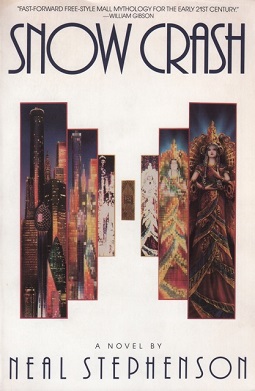
Snow Crash is a science fiction novel by the American writer Neal Stephenson, published in 1992. Like many of Stephenson's novels, its themes include history, linguistics, anthropology, archaeology, religion, computer science, politics, cryptography, memetics, and philosophy.

The Age of Spiritual Machines: When Computers Exceed Human Intelligence is a non-fiction book by inventor and futurist Ray Kurzweil about artificial intelligence and the future course of humanity. First published in hardcover on January 1, 1999, by Viking, it has received attention from The New York Times, The New York Review of Books and The Atlantic. In the book Kurzweil outlines his vision for how technology will progress during the 21st century.

Mind uploading is a speculative process of whole brain emulation in which a brain scan is used to completely emulate the mental state of the individual in a digital computer. The computer would then run a simulation of the brain's information processing, such that it would respond in essentially the same way as the original brain and experience having a sentient conscious mind.
Real life is a phrase used originally in literature to distinguish between the real world and fictional, virtual or idealized worlds, and in acting to distinguish between actors and the characters they portray. It has become a popular term on the Internet to describe events, people, activities, and interactions occurring offline; or otherwise not primarily through the medium of the Internet. It is also used as a metaphor to distinguish life in a vocational setting as opposed to an academic one, or adulthood and the adult world as opposed to childhood or adolescence.
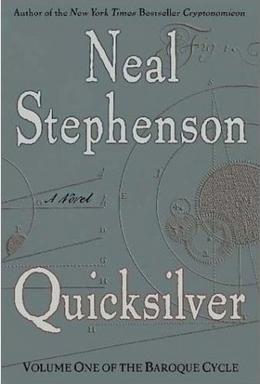
Quicksilver is a historical novel by Neal Stephenson, published in 2003. It is the first volume of The Baroque Cycle, his late Baroque historical fiction series, succeeded by The Confusion and The System of the World. Quicksilver won the Arthur C. Clarke Award and was nominated for the Locus Award in 2004. Stephenson organized the structure of Quicksilver such that chapters have been incorporated into three internal books titled "Quicksilver", "The King of the Vagabonds", and "Odalisque". In 2006, each internal book was released in separate paperback editions, to make the 900 pages more approachable for readers. These internal books were originally independent novels within the greater cycle during composition.

Ian Avrum Goldberg is a cryptographer and cypherpunk. He is best known for breaking Netscape's implementation of SSL, and for his role as chief scientist of Radialpoint, a Canadian software company. Goldberg is currently a professor at the Faculty of Mathematics of the David R. Cheriton School of Computer Science within the University of Waterloo, and the Canada Research Chair in Privacy Enhancing Technologies. He was formerly Tor Project board of directors chairman, and is one of the designers of off the record messaging.

The Baroque Cycle is a series of novels by American writer Neal Stephenson. It was published in three volumes containing eight books in 2003 and 2004. The story follows the adventures of a sizable cast of characters living amidst some of the central events of the late 17th and early 18th centuries in Europe, Africa, Asia, and Central America. Despite featuring a literary treatment consistent with historical fiction, Stephenson has characterized the work as science fiction, because of the presence of some anomalous occurrences and the work's particular emphasis on themes relating to science and technology. The sciences of cryptology and numismatics feature heavily in the series, as they do in some of Stephenson's other works.

Marco Brambilla is an Italian-born Canadian contemporary artist and film director, known for re-contextualizations of popular and found imagery, and use of 3D imaging technologies in public installations and video art.
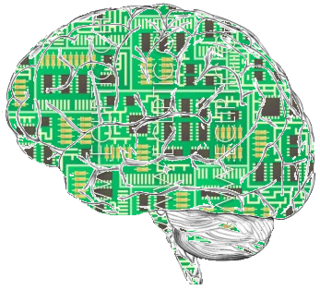
Mind uploading, whole brain emulation, or substrate-independent minds, is a use of a computer or another substrate as an emulated human brain. The term "mind transfer" also refers to a hypothetical transfer of a mind from one biological brain to another. Uploaded minds and societies of minds, often in simulated realities, are recurring themes in science-fiction novels and films since the 1950s.

William Duffy known professionally as William Dufris or Bill Dufris, was an American voice actor and audiobook narrator.
Connectomics is the production and study of connectomes: comprehensive maps of connections within an organism's nervous system. More generally, it can be thought of as the study of neuronal wiring diagrams with a focus on how structural connectivity, individual synapses, cellular morphology, and cellular ultrastructure contribute to the make up of a network. The nervous system is a network made of billions of connections and these connections are responsible for our thoughts, emotions, actions, memories, function and dysfunction. Therefore, the study of connectomics aims to advance our understanding of mental health and cognition by understanding how cells in the nervous system are connected and communicate. Because these structures are extremely complex, methods within this field use a high-throughput application of functional and structural neural imaging, most commonly magnetic resonance imaging (MRI), electron microscopy, and histological techniques in order to increase the speed, efficiency, and resolution of these nervous system maps. To date, tens of large scale datasets have been collected spanning the nervous system including the various areas of cortex, cerebellum, the retina, the peripheral nervous system and neuromuscular junctions.

Zendegi is a science fiction novel by Australian author Greg Egan, first published in the United Kingdom by Gollancz in June 2010. It is set in Iran in the near future and deals with mapping the human brain, virtual reality and the democratization of Iran. The title of the book means "life" in Persian; the name of the virtual reality system featured in the story is Zendegi-ye Behtar, Persian for "better life".
The Human Connectome Project (HCP) is a five-year project sponsored by sixteen components of the National Institutes of Health, split between two consortia of research institutions. The project was launched in July 2009 as the first of three Grand Challenges of the NIH's Blueprint for Neuroscience Research. On September 15, 2010, the NIH announced that it would award two grants: $30 million over five years to a consortium led by Washington University in St. Louis and the University of Minnesota, with strong contributions from University of Oxford (FMRIB) and $8.5 million over three years to a consortium led by Harvard University, Massachusetts General Hospital and the University of California Los Angeles.
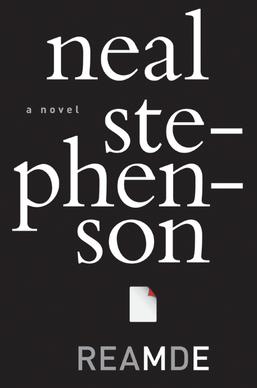
Reamde is a technothriller novel by Neal Stephenson, published in 2011. The story, set in the present day, centers on the plight of a hostage and the ensuing efforts of family and new acquaintances, many of them associated with a fictional MMORPG, to rescue her as her various captors drag her about the globe. Topics covered range from online activities including gold farming and social networking to the criminal methods of the Russian mafia and Islamic terrorists.
Virtual reality in fiction describes fictional representations of the technological concept of virtual reality.

The Cardiff University Brain Research Imaging Centre (CUBRIC) is a brain imaging centre, part of Cardiff University's Science and Innovation Campus in Cardiff, Wales, United Kingdom. When it expanded in 2016, it was considered the most advanced brain imaging centre in Europe.
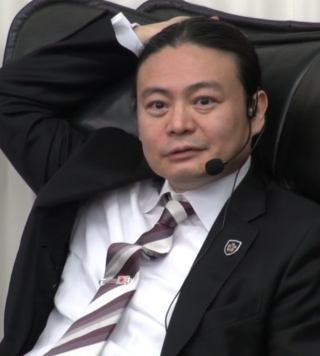
Hideto Tomabechi is a Japanese cognitive scientist computer scientist.














